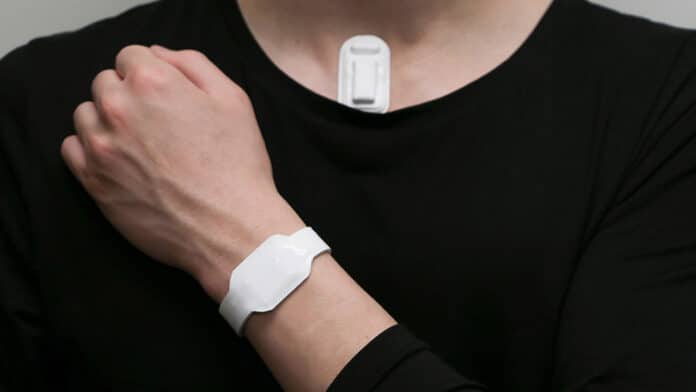For many people who make their livings by speaking or singing, vocal fatigue is a constant, looming threat. The common condition occurs when overused vocal folds swell, making the voice sound raspy and lose endurance.
To help keep that from happening, Northwestern University researchers have developed the first smart wearable device to continuously track how much people use their voices, alerting them to overuse before vocal fatigue and potential injury set in.
The new technology is developed by an interdisciplinary team of materials scientists, biomedical engineers, opera singers, and a speech-language pathologist led by Northwestern University’s Prof. John A. Rogers. Researchers believe that their battery-powered, wireless device and accompanying algorithms could be a game-changer for professional singers, teachers, politicians, call-center workers, coaches, and anyone who relies on their voices to communicate effectively and make a living.
The soft, flexible, postage-stamp-sized device comfortably adheres to the skin over the wearer’s sternum, below the neck, to sense the subtle vibrations associated with talking and singing. From there, the captured data is instantaneously streamed via Bluetooth to the user’s smartphone or tablet through an app. This helps them monitor their vocal activities in real-time throughout the day and measure cumulative total vocal usage.
Machine-learning-based algorithms then process the data and distinguish the difference between speaking and singing, enabling singers to separately track each activity. The algorithms are claimed to separate singing from speaking with more than 95% accuracy.
The user can set their personalized vocal thresholds using the app. When they near that threshold, their smartphone, smartwatch, or an accompanying device located on the wrist provides real-time haptic feedback as an alert. Then, they can rest their voices before pushing it too far. It is said that even brief 15 to 20 minutes of total silence interspersed throughout the day can help vocal fold tissues recover and repair.
This haptic device includes multiple motors that can activate in different patterns and with varying levels of intensity to convey different messages. Importantly, for the privacy-conscious, the new device also senses vibrations rather than recording what the user is saying.
“It’s easy for people to forget how much they use their voice,” said Northwestern’s Theresa Brancaccio, a voice expert who co-led the study. “Seasoned classical singers tend to be more aware of their vocal usage because they have lived and learned. But some people – especially singers with less training or people like teachers, politicians, and sports coaches, who must speak a lot for their jobs – often don’t realize how much they are pushing it. We want to give them greater awareness to help prevent injury.”
Journal reference:
- Hyoyoung Jeong, Jae-Young Yoo, Wei Ouyang, Aurora Lee Jean Xue Greane, Alexandra Jane Wiebe, Ivy Huang, Young Joong Lee, Jong Yoon Lee, Joohee Kim, Xinchen Ni, Suyeon Kim, Huong Le-Thien Huynh, Isabel Zhong, Yu Xuan Chin, Jianyu Gu, Aaron M. Johnson, Theresa Brancaccio, and John A. Rogers. Closed-loop network of skin-interfaced wireless devices for quantifying vocal fatigue and providing user feedback. Proceedings of the National Academy of Sciences, 2023; DOI: 10.1073/pnas.2219394120
